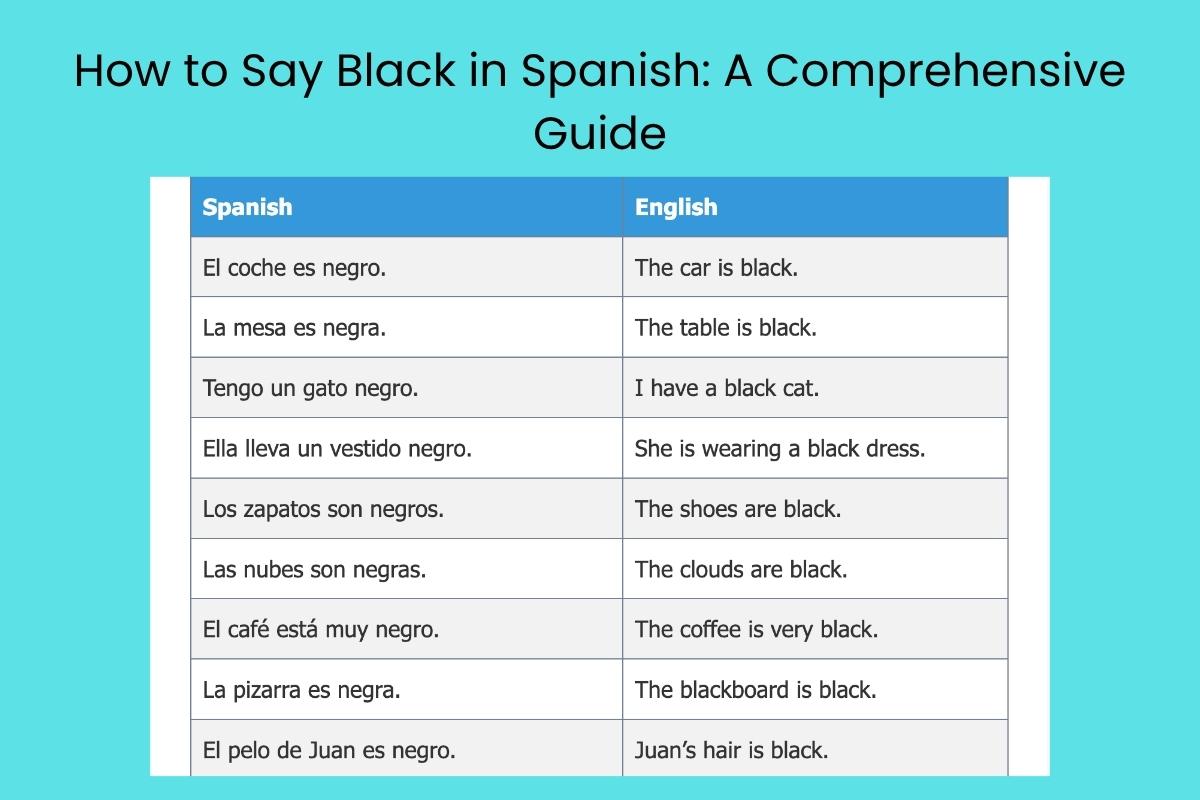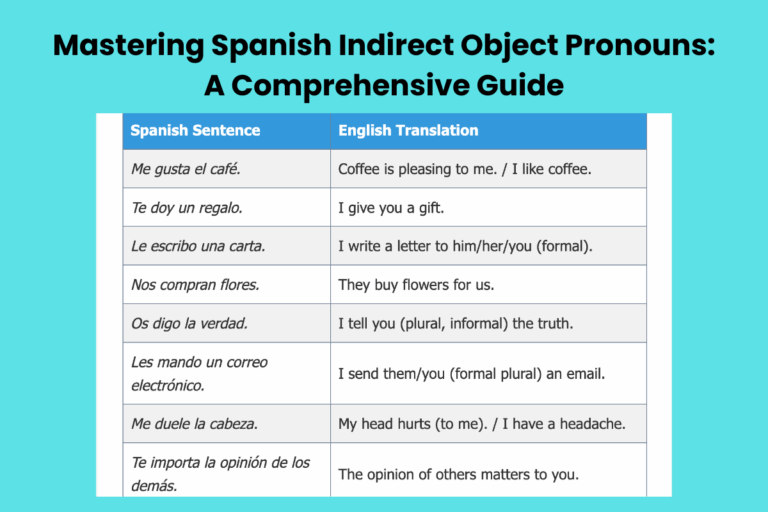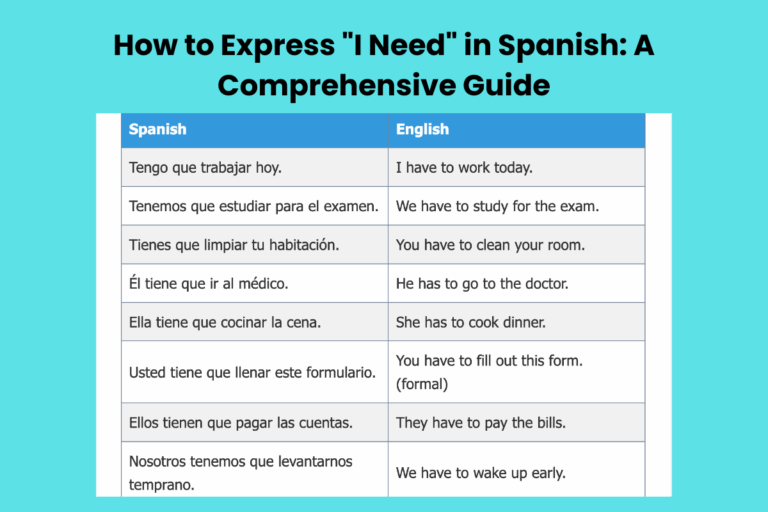How to Say Black in Spanish: A Comprehensive Guide
Understanding how to express colors in a different language is a foundational element of language acquisition. Specifically, knowing how to say “black” in Spanish is essential for describing objects, expressing emotions, and understanding cultural nuances.
This article offers a comprehensive guide to mastering the use of “black” in Spanish, covering its various forms, grammatical rules, common mistakes, and practical applications. Whether you’re a beginner or an advanced learner, this guide will provide you with the knowledge and practice needed to confidently use “black” in your Spanish conversations and writing.
This guide is designed for students, travelers, and anyone interested in learning Spanish. By the end of this article, you will have a solid understanding of the correct usage of “black” in Spanish, including its different forms based on gender and number, common phrases, and potential pitfalls to avoid.
Mastering this seemingly simple concept will significantly enhance your ability to communicate effectively and accurately in Spanish.
Table of Contents
- Introduction
- Definition of Black in Spanish
- Structural Breakdown
- Types and Categories
- Examples of Black in Spanish
- Usage Rules
- Common Mistakes
- Practice Exercises
- Advanced Topics
- FAQ
- Conclusion
Definition of Black in Spanish
In Spanish, the word for “black” is negro (masculine) and negra (feminine). The form used depends on the gender of the noun it modifies. “Negro” and “negra” function primarily as adjectives, describing the color of a noun. They can also be used as nouns themselves, referring to the color black or, historically and controversially, to a person of African descent. However, it’s crucial to be aware of the potential for offense and use alternative terminology when referring to people.
The word originates from the Latin word “niger,” meaning black. Its function is to describe color, but it can also express abstract concepts like darkness, sadness, or formality.
Context is key when interpreting the meaning of “negro” or “negra” in Spanish. For example, “humor negro” translates to “dark humor,” and “mercado negro” translates to “black market.” Understanding these nuances is essential for effective communication.
Classification
“Negro” and “negra” are primarily classified as adjectives because they modify nouns to describe their color. However, they can also function as nouns, especially when referring to the color itself.
In these cases, they require the use of a definite article (el or la). For example, “El negro es mi color favorito” means “Black is my favorite color.”
Function
The primary function of “negro” and “negra” is to describe the color black. They can also be used metaphorically to convey negative emotions or connotations.
For example, “un día negro” means “a black day,” which signifies a bad or unfortunate day. The function can also extend to describing objects, animals, and even abstract concepts, providing a versatile tool for descriptive language.
Contexts
The words “negro” and “negra” are used in a wide range of contexts, from everyday conversations to formal writing. You might use them to describe the color of your car, your clothes, or even your coffee.
In literature and poetry, “negro” and “negra” can be used to create vivid imagery and evoke specific emotions. In business contexts, you might encounter terms like “lista negra” (blacklist).
Understanding the context is crucial for interpreting the intended meaning and avoiding miscommunication. It’s particularly important to be sensitive to the historical and social implications of the word, especially when referring to people.
Structural Breakdown
The structure of “negro” and “negra” is relatively straightforward. They are both single-word adjectives that change their ending to agree in gender with the noun they modify.
The masculine form is “negro,” and the feminine form is “negra.” The plural forms are “negros” and “negras,” respectively.
The agreement rule is fundamental to Spanish grammar. Adjectives must agree in both gender and number with the nouns they modify.
This means that if you are describing a masculine singular noun, you must use “negro.” If you are describing a feminine singular noun, you must use “negra.” The same principle applies to plural nouns.
Here’s a table illustrating the agreement rules:
| Noun | Gender | Number | Adjective Form | Example |
|---|---|---|---|---|
| Coche (car) | Masculine | Singular | Negro | El coche negro (The black car) |
| Casa (house) | Feminine | Singular | Negra | La casa negra (The black house) |
| Gatos (cats) | Masculine | Plural | Negros | Los gatos negros (The black cats) |
| Mesas (tables) | Feminine | Plural | Negras | Las mesas negras (The black tables) |
Understanding these agreement rules is crucial for constructing grammatically correct sentences in Spanish. Failing to adhere to these rules can lead to confusion and miscommunication.
Therefore, it is essential to practice and internalize these patterns.
Types and Categories
The word “negro/negra” can be categorized based on its grammatical function and its contextual meaning. Here’s a breakdown of the different types and categories:
Adjective
As an adjective, “negro/negra” describes the color of a noun. This is the most common usage.
Examples include:
- Un perro negro (A black dog)
- Una camisa negra (A black shirt)
- Los zapatos negros (The black shoes)
- Las nubes negras (The black clouds)
Noun
As a noun, “negro/negra” refers to the color black itself. It typically requires a definite article.
Examples include:
- El negro es mi color favorito. (Black is my favorite color.)
- Prefiero el negro al blanco. (I prefer black to white.)
Idiomatic Expressions
The word “negro/negra” appears in several idiomatic expressions, where its meaning may be figurative. Examples include:
- Humor negro (Dark humor)
- Mercado negro (Black market)
- Oveja negra (Black sheep)
- Verlo todo negro (To see everything negatively)
Historical Context
Historically, the term “negro/negra” has been used to refer to people of African descent. However, this usage is now considered offensive and should be avoided.
It is crucial to use respectful and appropriate language when referring to people’s race or ethnicity. Terms like “afrodescendiente” or “persona de color” are generally preferred.
Examples of Black in Spanish
Here are several examples of how to use “negro” and “negra” in different contexts. The examples are organized into tables for clarity and ease of understanding.
Describing Objects
This table provides examples of using “negro” and “negra” to describe various objects.
| Spanish | English |
|---|---|
| El coche es negro. | The car is black. |
| La mesa es negra. | The table is black. |
| Tengo un gato negro. | I have a black cat. |
| Ella lleva un vestido negro. | She is wearing a black dress. |
| Los zapatos son negros. | The shoes are black. |
| Las nubes son negras. | The clouds are black. |
| El café está muy negro. | The coffee is very black. |
| La pizarra es negra. | The blackboard is black. |
| El pelo de Juan es negro. | Juan’s hair is black. |
| La noche es negra. | The night is black. |
| Compré un bolso negro. | I bought a black bag. |
| El cuadro tiene un marco negro. | The painting has a black frame. |
| La televisión tiene una pantalla negra. | The television has a black screen. |
| El teclado es negro. | The keyboard is black. |
| La bicicleta es negra. | The bicycle is black. |
| El cuaderno tiene una tapa negra. | The notebook has a black cover. |
| El teléfono es negro. | The phone is black. |
| La cortina es negra. | The curtain is black. |
| La alfombra es negra. | The carpet is black. |
| El sombrero es negro. | The hat is black. |
| La tinta es negra. | The ink is black. |
| El traje es negro. | The suit is black. |
| La sombra es negra. | The shadow is black. |
Expressing Feelings and Abstract Concepts
This table demonstrates how “negro” and “negra” can be used to express feelings and abstract concepts.
| Spanish | English |
|---|---|
| Hoy tengo un día negro. | I’m having a black day today. (A bad day) |
| Veo el futuro negro. | I see the future as black. (Pessimistic view) |
| Tiene un humor negro. | He/She has a dark sense of humor. |
| La situación se ve muy negra. | The situation looks very black. (Bleak situation) |
| La noticia fue un golpe negro. | The news was a black blow. (A very bad blow) |
| Siente una tristeza negra. | He/She feels a black sadness. (Deep sadness) |
| El mercado negro es ilegal. | The black market is illegal. |
| La oveja negra de la familia. | The black sheep of the family. |
| El luto se representa con el color negro. | Mourning is represented with the color black. |
| La magia negra es peligrosa. | Black magic is dangerous. |
| Se vistió de negro para el funeral. | He/She dressed in black for the funeral. |
| La lista negra de empleados. | The blacklist of employees. |
| Pintó su habitación de negro para sentirse diferente. | He/She painted their room black to feel different. |
| El café negro me ayuda a despertar. | Black coffee helps me wake up. |
| El gato negro trajo mala suerte. | The black cat brought bad luck. |
| La noche negra ocultaba sus secretos. | The black night hid his/her secrets. |
| El humor negro es su especialidad. | Dark humor is his/her specialty. |
| El futuro se veía negro después del desastre. | The future looked black after the disaster. |
| El corazón negro simboliza la tristeza. | The black heart symbolizes sadness. |
| El alma negra refleja la maldad. | The black soul reflects evil. |
Common Phrases
This table provides examples of common phrases that use “negro” and “negra.”
| Spanish | English |
|---|---|
| De noche todos los gatos son pardos. | At night, all cats are grey. (All things are the same in the dark) |
| Ver las cosas negras. | To see things negatively. |
| Ponerse negro. | To get angry (literally, to turn black). |
| Dinero negro. | Black money (undeclared income). |
| Trabajo en negro. | Working under the table (undeclared work). |
| Estar en números rojos/negros. | To be in the red/black (to be in debt/to be making profit). |
| Tener la conciencia negra. | To have a guilty conscience. |
| Pasar la noche en negro. | To spend a sleepless night. |
| No ver ni negro. | To not see anything at all. |
| Vestir de negro riguroso. | To dress in full black. |
| Tener la suerte negra. | To have very bad luck. |
| Ver todo negro. | To see everything negatively. |
| Escribir con tinta negra. | To write with black ink. |
| Tener una visión negra del mundo. | To have a dark view of the world. |
| Poner algo por escrito en negro sobre blanco. | To put something in writing, black on white. |
| Dejar a alguien negro. | To exhaust someone. |
| Trabajar como un negro. | To work very hard (use with caution, potentially offensive). |
Usage Rules
The primary rule for using “negro” and “negra” is to ensure agreement with the noun in both gender and number. However, there are some additional nuances to consider.
Agreement: As mentioned, adjectives must agree with the nouns they modify. For example:
- El gato negro (The black cat – masculine singular)
- La gata negra (The black cat – feminine singular)
- Los gatos negros (The black cats – masculine plural)
- Las gatas negras (The black cats – feminine plural)
Placement: In Spanish, adjectives typically follow the noun they modify. However, certain adjectives, including those of color, can sometimes precede the noun for emphasis or stylistic effect. While less common, “negro” and “negra” can be placed before the noun.
- El coche negro (The black car – typical)
- El negro coche (The black car – emphatic)
Compound Adjectives: When “negro” or “negra” is part of a compound adjective, only the last adjective agrees with the noun. For example:
- Un vestido blanco y negro (A black and white dress)
- Unos zapatos rojo y negro (Red and black shoes)
Using as a Noun: When using “negro” or “negra” as a noun, it requires a definite article (el or la) and refers to the color itself.
- El negro es un color popular. (Black is a popular color.)
- La negra es un color elegante. (Black is an elegant color.)
Common Mistakes
One of the most common mistakes is failing to ensure gender and number agreement. Here are some examples of incorrect and correct usage:
| Incorrect | Correct | Explanation |
|---|---|---|
| El casa negro | La casa negra | “Casa” is feminine, so the adjective must be “negra.” |
| Las coches negra | Los coches negros | “Coche” is masculine and plural, so the adjective must be “negros.” |
| Un libro negras | Un libro negro | “Libro” is masculine and singular, so the adjective must be “negro.” |
| El mesa negro | La mesa negra | “Mesa” is feminine, so the adjective must be “negra.” |
Another common mistake is using “negro/negra” to refer to people. It is crucial to avoid this usage and opt for more respectful terms like “afrodescendiente” or “persona de color.” Using “negro/negra” in this context can be offensive and perpetuate harmful stereotypes.
For instance, instead of saying “Él es negro,” say “Él es afrodescendiente” or “Él es una persona de color.” This demonstrates respect and avoids potential offense.
Practice Exercises
Test your understanding of “negro” and “negra” with these practice exercises.
Exercise 1: Choose the Correct Form
Choose the correct form of “negro” or “negra” to complete the following sentences.
| Question | Answer |
|---|---|
| 1. El cielo está ______. | negro |
| 2. La noche es ______. | negra |
| 3. Los gatos son ______. | negros |
| 4. Las camisas son ______. | negras |
| 5. Tengo un perro ______. | negro |
| 6. Ella tiene una falda ______. | negra |
| 7. Los zapatos son ______. | negros |
| 8. Las uvas son ______. | negras |
| 9. El coche es ______. | negro |
| 10. La casa es ______. | negra |
Exercise 2: Translate the Sentences
Translate the following sentences into Spanish, using the correct form of “negro” or “negra.”
| English | Spanish |
|---|---|
| 1. The black dog is running. | El perro negro está corriendo. |
| 2. The black cat is sleeping. | La gata negra está durmiendo. |
| 3. The black cars are expensive. | Los coches negros son caros. |
| 4. The black tables are old. | Las mesas negras son viejas. |
| 5. I have a black shirt. | Tengo una camisa negra. |
| 6. He has black shoes. | Él tiene zapatos negros. |
| 7. The black clouds are approaching. | Las nubes negras se acercan. |
| 8. The black coffee is strong. | El café negro es fuerte. |
| 9. The black board is dirty. | La pizarra negra está sucia. |
| 10. She has black hair. | Ella tiene el pelo negro. |
Exercise 3: Fill in the Blanks
Fill in the blanks with the appropriate form of “negro” or “negra” to complete the sentences.
| Question | Answer |
|---|---|
| 1. El gato ______ está en el jardín. | negro |
| 2. La noche ______ es muy oscura. | negra |
| 3. Los zapatos ______ son nuevos. | negros |
| 4. Las cortinas ______ están cerradas. | negras |
| 5. Un coche ______ pasó por la calle. | negro |
| 6. Una casa ______ fue vendida ayer. | negra |
| 7. Los libros ______ son interesantes. | negros |
| 8. Las flores ______ son raras. | negras |
| 9. El café ______ es mi favorito. | negro |
| 10. La pizarra ______ está en el aula. | negra |
Advanced Topics
For advanced learners, understanding more nuanced uses of “negro” and “negra” can enhance your fluency and cultural sensitivity.
Figurative Language: Explore the use of “negro/negra” in metaphors and similes. For example, “estar más negro que el carbón” (to be blacker than coal) implies being very dirty or tanned. These expressions add depth to your language skills.
Historical and Social Context: Research the historical and social implications of the term “negro/negra” in different Spanish-speaking countries. Understanding the historical context is crucial for avoiding offensive language and promoting respectful communication. For example, in some regions, the term might carry more weight than in others, and it’s important to be aware of these differences.
Regional Variations: Investigate regional variations in the usage of “negro/negra.” While the basic meaning remains the same, certain regions might have unique idiomatic expressions or connotations associated with the term. For example, a phrase common in Spain might not be used or understood in Mexico.
Subjunctive Mood: Practice using “negro/negra” in sentences that require the subjunctive mood. This will further refine your grammar skills and allow you to express more complex ideas. For instance, “Es importante que el coche sea negro” (It’s important that the car is black) uses the subjunctive mood.
FAQ
Here are some frequently asked questions about using “black” in Spanish.
- Q: How do I say “black” when referring to a person?
A: Avoid using “negro/negra” to refer to a person. Instead, use terms like “afrodescendiente” or “persona de color.” - Q: What is the difference between “negro” and “negra”?
A: “Negro” is the masculine form, and “negra” is the feminine form. They must agree in gender with the noun they modify. - Q: Can I use “negro” as a noun?
A: Yes, but it requires a definite article (el or la). For example, “El negro es mi color favorito.” - Q: Is it rude to say “negro” in Spanish?
A: When referring to a person, yes, it is generally considered rude and offensive. It’s best to use alternative terms. When referring to the color, it is generally acceptable, but it’s always good to be mindful of the context. - Q: How do I say “black and white” in Spanish?
A: “Blanco y negro.” For example, “una foto en blanco y negro” (a black and white photo). - Q: What does “humor negro” mean?
A: “Humor negro” means “dark humor.” - Q: How do I use “negro” in a sentence about clothing?
A: Make sure the adjective agrees in gender and number with the clothing item. For example, “una camisa negra” (a black shirt) or “unos pantalones negros” (black pants). - Q: What are some common idioms that use “negro”?
A: Some common idioms include “mercado negro” (black market), “oveja negra” (black sheep), and “verlo todo negro” (to see everything negatively). - Q: Where does the word ‘negro’ come from?
A: It comes from the Latin word ‘niger,’ which also means ‘black.’ - Q: Is the placement of the adjective ‘negro’ flexible?
A: Yes, the adjective placement is flexible, though it usually comes after the noun it modifies. Placing it before the noun is for emphasis.
Conclusion
Mastering the use of “black” in Spanish, “negro” and “negra,” is a fundamental step in becoming proficient in the language. By understanding the grammatical rules, common usages, and potential pitfalls, you can communicate more effectively and accurately.
Remember to always ensure agreement in gender and number, and be mindful of the context to avoid misunderstandings or offense.
Continue practicing with real-life examples and engaging in conversations to solidify your knowledge. Don’t be afraid to make mistakes – they are a natural part of the learning process.
With consistent effort and attention to detail, you will confidently and accurately use “black” in Spanish, enhancing your overall language skills and cultural awareness. Embrace the nuances of the language, and enjoy the journey of learning Spanish!







